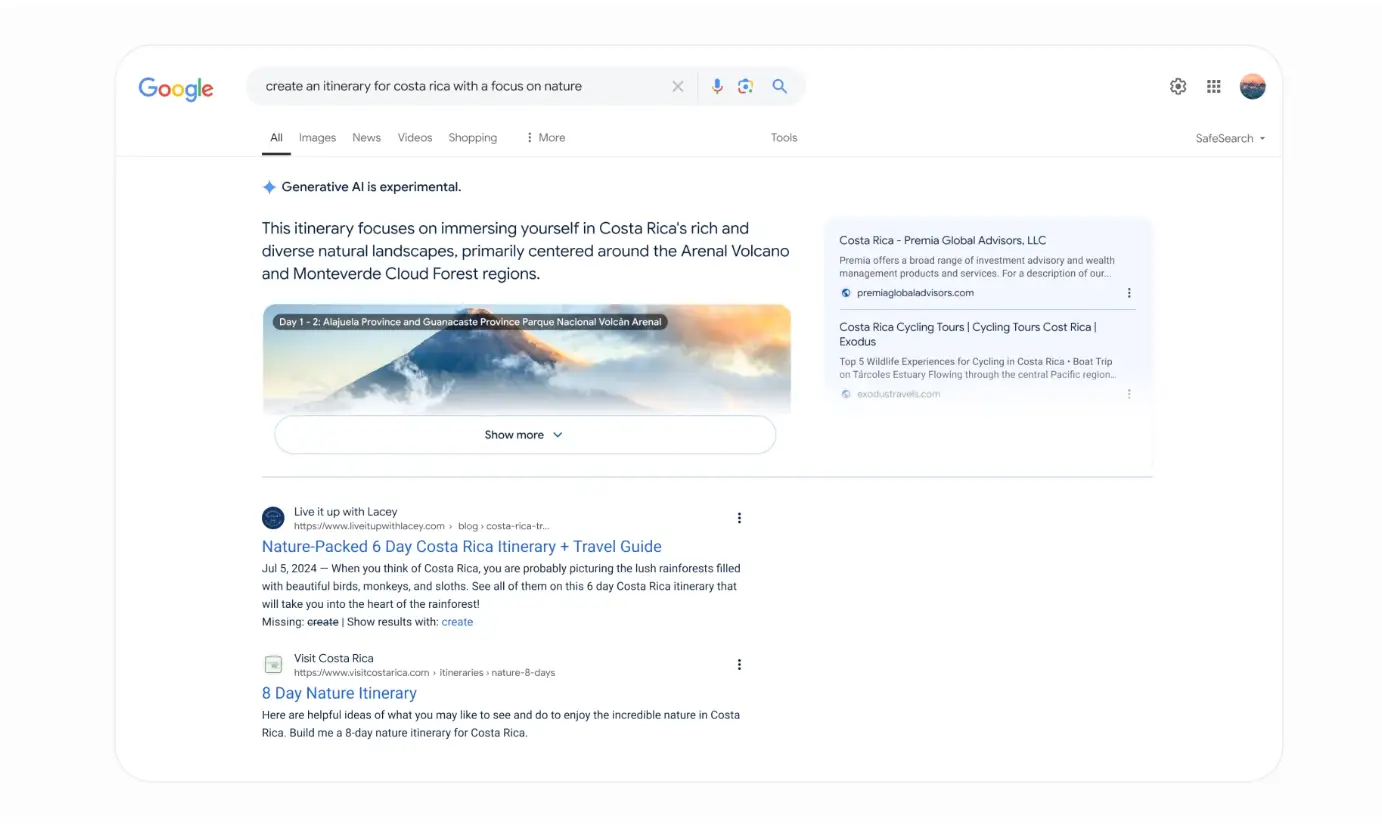Google adds new AI travel features just in time for summer, making it easier than ever to plan trips with the help of Search, Maps, Lens, and Gemini.
These updates are designed to simplify everything from choosing a destination to creating itineraries and saving hotel deals—turning your next vacation into a more seamless, personalized experience powered by artificial intelligence.
Google’s AI Overviews Can Build Your Dream Itinerary
One of the most exciting updates is the expansion of AI Overviews in Google Search. This feature now allows users to request complete, day-by-day itineraries not only for popular cities like Rome or New York, but also for entire countries or specific regions. A simple search like “create an itinerary for Costa Rica with a focus on nature” will generate travel suggestions, complete with photos, user reviews, and an expandable map view. Once ready, these itineraries can be exported directly to Google Docs or Gmail, or saved as a custom list in Google Maps.
This feature is currently available for English language queries on mobile and desktop in the U.S. and does not require enrollment in Search Labs. It represents a major step forward in integrating real-time AI assistance into traditional travel research tools.
Track Hotel Prices Before You Book
Another helpful addition is hotel price tracking, which now joins Google Flights in offering automatic alerts for price drops. If you’re searching on google.com/hotels, you’ll notice a new toggle option that allows you to track hotel prices for specific dates and destinations. Google will then send an email notification if prices drop significantly for properties that match your search criteria, including filters like location, amenities, or star rating. The feature is rolling out globally this week across both mobile and desktop platforms.
Turn Screenshots Into Interactive Travel Plans
Google Maps is also getting smarter when it comes to travel planning. A new feature turns your phone’s screenshots into usable travel plans. Many travelers take screenshots of restaurants, attractions, or recommendations they find online, but these images often get lost in a cluttered camera roll. Now, when users activate the “screenshot” list feature in Maps, Gemini’s AI capabilities will scan and identify landmarks and locations mentioned in those images. These places can be reviewed, saved, and displayed on a personalized map—making it easy to organize ideas and share trip plans with friends.
This screenshot-based list function is launching in English for iOS users in the U.S., with an Android rollout expected soon. It’s a creative new way to bridge visual inspiration and functional itinerary planning using AI.
Gemini Becomes Your Personal Travel Assistant
For travelers who need help deciding where to go or what to do, Google is also highlighting its AI assistant Gemini. You can now ask Gemini to help brainstorm trip ideas, find budget-friendly destinations, or recommend local activities based on your interests. For example, a query like “find me the cheapest flights to Europe and YouTube videos on what to do in those cities” will generate a range of useful results. Gemini can also act as a travel guide using the Gems feature—a customizable AI module that lets users create their own virtual assistant for specific tasks like packing suggestions or food recommendations.
Gems are now available to all users for free, and travelers can set up their personalized planning assistant by accessing the Gems Manager on desktop. The AI even helps users write their Gem’s instructions, making it easier to create a tool tailored to individual travel needs.
Explore the World Through Your Camera With Google Lens
Google Lens rounds out the suite of updates by enhancing the way users interact with their surroundings while traveling. Whether you’re visiting a city like Florence or exploring a small village, you can now point your camera and ask, “what is this?” to get an AI-generated overview of the landmark or object in view. This also works well for translating foreign text, identifying architecture, or learning more about cultural artifacts on the go. The AI-powered Lens feature is expanding support to more languages including Hindi, Indonesian, Japanese, Korean, Portuguese, and Spanish in many countries where AI Overviews are available.
Together, these updates showcase Google’s evolving role in the travel ecosystem. With tools that span from itinerary creation to real-time price tracking and interactive AI guidance, the company is reshaping how people approach vacation planning. As AI becomes more intuitive and accessible, travelers can expect less stress and more discovery—whether they’re flying across the globe or exploring their own backyard.
Are you using Google’s new travel tools for your next adventure? Share your experience and let us know which feature you’re most excited to try!














